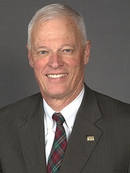Health care is the best it's ever been in some parts of the world — but not everywhere, and radiologists are positioned to close the gap on the quality of care across the world, according to RSNA President James P. Borgstede, MD.

Borgstede
"We don't have to operate in two different health care worlds — the highly resourced and the under-resourced," he said. "As a specialty, we can impact health care equity."
During his opening address on Sunday, Dr. Borgstede underscored the theme of this year's meeting, "Human Insight/Visionary Medicine," as two sides of the same coin, reflecting the need to combine the power of humans and technology to innovate and improve patient care.
"Visionary medicine is a powerful, expansive concept," he said. "Our insights and vision carry us into the future. Our specialty of radiology has unique advantages that put us in a leadership position because of its precise combination of humans and technology."
Dr. Borgstede lauded the role of radiologists in the early stages of the COVID-19 pandemic as he envisioned a future of greater health care equity.
"We have all been dramatically affected by COVID," he said. "Early in the pandemic, radiologists and imaging played an important role in patient care until lab tests were established. Our struggles against this virus punctuate the power of humans and technology coming together to innovate and improve care for our patients."
Radiology's Role in Closing the Gap in Health Care Equity
Dr. Borgstede posited that radiology, which is rich in both human and technological resources, can be a conduit for health care improvement worldwide. By connecting radiology communities across the globe, the specialty can become what author Thomas Friedman refers to as a "flattener" in his book The World is Flat. Flatteners, according to Friedman, drive globalization and create equal opportunities.
"Radiologists, patients, our technology and professional organizations are each powerful global flatteners," he said. "But their greatest capacity to even out care across the world accelerates when they converge. We need to aspire to a world of global convergence."
A generation ago, RSNA and other organizations joined forces with vendors to develop the DICOM model, creating a universal language. And collaborations to advance high-quality patient care continue. At the onset of the COVID-19 pandemic, RSNA worked with other international organizations to develop a consensus statement on thoracic imaging.
"RSNA provided educational and research materials to assist radiologists worldwide in addressing the need for consistency in patient care," he said.
Dr. Borgstede reminded radiologists that technology will not achieve the innate humanity of medicine — it can only augment and enhance the performance of the radiologist.
"Technology does not make physicians current, intelligent, ethical, just and honest," he said. "These very human attributes are needed to care for our patients and direct the future use of technology for their benefit."
He illustrated this point with the story of a young patient at his institution whose family was moved from being angry to being reassured because of a radiologist who explained the nuances of the radiology reports to them. They became an advocate for the radiology department.
"There is no substitute for human to human interaction in radiology," Dr. Borgstede said.
A Future Defined by Worldwide Collaboration, Unity, Connection
Achieving the vision of a collaborative, flattened radiology world will not be without its challenges, he said. "There is a deep chasm between two different worlds of health care. We must make a conscious choice to collaborate worldwide."
Because every patient around the world will at some point require imaging, Dr. Borgstede said radiologists have the potential to be the epicenter of patients' health care.
"We must envision how we can enable the best radiology for everyone," he said. "I challenge each of you to consider the talks you hear and the technologies you see this week and decide how you can encourage worldwide convergence that benefits our patients."
Radiologists are the stewards of the flatteners for change, Dr. Borgstede said, whose future will be defined by worldwide collaboration, unity and connection, and whose vision can make the two worlds of radiology one.
"We must maintain a prospective vision of what can and should be," he said. "A troubled specialty is one that tells everyone how good things were in the past."
Dr. Borgstede reminded his audience that radiology is a specialty of infinite opportunities, an infinite combination of technology and the human spirit.
"We must be the specialty whose vision exceeds its memories."
For More Information
View the RSNA 2020 session One World, One Radiology Community-A Vision for Tomorrow — PS10 at RSNA2020.RSNA.org.

